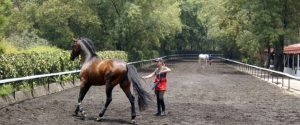Beatriz used to have a horse registered with the practice and I had to treat him on a number of occasions for a chronic sacro-iliac problem. This required various physiotherapy/chiropractic manipulations to keep him sound and going well.
He was a dressage horse and worked at PSG level and above.
Since returning to Mexico, Beatriz has become involved in judging and had on a number of occasions noted that some of the horses were crooked or not moving straight when she was at a number of dressage competitions. So on her suggestion I was asked to fly over to Mexico to help with sorting these problems out.So having had a variety of communications with a number of unknown people I boarded a plane and flew to Mexico – I was not really sure if I would be met at the airport but having found a worried looking driver ( I was last through customs) who was holding up a board with my name , I at least thought the trip would go according to plan!
On my arrival in Mexico City I was met by Omar Zayrik who was a recent Pan American Dressage winner and his close friend Berna Pujals who had achieved a remarkable 9th place at the 2008 Beijing Olympic Games on her horse Vincent. Both Omar and Berna realise that in order to compete on a worldwide basis that they need to keep up with the likes of Charlotte Dujardin and Carl Hester. And so they are embarking on a plan to try and maximise every aspect of preparing theirs horses for dressage ranging from exploring to the smallest of detail feeding regimes , saddle fitting, shoeing, physiotherapy, supplement’s, etc. etc. , as they realise at the top level every single percentage point gained in a test makes so much difference. My remit was to examine the horses and see if there was anything I could do from a chiropractic/physiotherapist/veterinary point of view.
The horses I examined were mainly based at a stable yard in the centre of Mexico City where there were about 200 horses. The horses were mainly dressage horses although there were a few show jumpers too. The yard had no paddock turn out and the horses were stabled 24 hours a day apart form when they were ridden or turned out into a small dirt square about 15metres square or when they were walked in hand around the yard for a few minutes. There was a swimming pool too but this wasn’t used very often. They had a covered school and two further outside schools with a canter track around the outside of the stables. Horses were never hacked out because the yard was located virtually in the middle of a commercial area.
I did also spend some time at a local military facility where there were again about 200 horses but at least here there was access to paddocks and even a cross country course. There I was met a group of enthusiastic officers and a top ranking General who had come to watch what I was doing and to ask as many questions as they possibly could.
The facility is government backed and they are trying to establish teams of riders who are able to compete worldwide in every discipline. Hand in hand with this is a breeding programme aimed at improving competition horses breeding lines. The advent of frozen semen being available worldwide has meant they have been using some of the top European stallions on their mares.
Over the four days I was there I treated 40 horses all of which had various problems most of them I commonly find in dressage horses that do the same thing day in day out. What was good from my perspective was that I could spend all my time and effort concentrating on the musculo-skeletal systems of these horses without worrying about getting to my next call on time!
Having started at 8.00am and not finishing until 8.30pm without stopping I must admit by the end of my trip I was slightly exhausted but everyone I met was so friendly and passionate about their horses time just seemed to fly by.
One thing of note that I did find interesting was that having gone with the preconception of finding lame horses with bad back from ill-fitting saddles I was pleasantly surprised to find that out of the forty horses I treated not one of them had an ill-fitting saddle. What is remarkable and possibly poignant about that is that the owners buy their own saddles and fit them themselves!
Beatriz used to have a horse registered with the practice and I had to treat him on a number of occasions for a chronic sacro-iliac problem. This required various physiotherapy/chiropractic manipulations to keep him sound and going well. He was a dressage horse and worked at PSG level and above.
Since returning to Mexico, Beatriz has become involved in judging and had on a number of occasions noted that some of the horses were crooked or not moving straight when she was at a number of dressage competitions. So on her suggestion I was asked to fly over to Mexico to help with sorting these problems out.
So having had a variety of communications with a number of unknown people I boarded a plane and flew to Mexico – I was not really sure if I would be met at the airport but having found a worried looking driver ( I was last through customs) who was holding up a board with my name , I at least thought the trip would go according to plan!
On my arrival in Mexico City I was met by Omar Zayrik who was a recent Pan American Dressage winner and his close friend Berna Pujals who had achieved a remarkable 9th place at the 2008 Beijing Olympic Games on her horse Vincent. Both Omar and Berna realise that in order to compete on a worldwide basis that they need to keep up with the likes of Charlotte Dujardin and Carl Hester. And so they are embarking on a plan to try and maximise every aspect of preparing theirs horses for dressage ranging from exploring to the smallest of detail feeding regimes , saddle fitting, shoeing, physiotherapy, supplement’s, etc. etc. , as they realise at the top level every single percentage point gained in a test makes so much difference. My remit was to examine the horses and see if there was anything I could do from a chiropractic/physiotherapist/veterinary point of view.
The horses I examined were mainly based at a stable yard in the centre of Mexico City where there were about 200 horses. The horses were mainly dressage horses although there were a few show jumpers too. The yard had no paddock turn out and the horses were stabled 24 hours a day apart form when they were ridden or turned out into a small dirt square about 15metres square or when they were walked in hand around the yard for a few minutes. There was a swimming pool too but this wasn’t used very often. They had a covered school and two further outside schools with a canter track around the outside of the stables. Horses were never hacked out because the yard was located virtually in the middle of a commercial area.
I did also spend some time at a local military facility where there were again about 200 horses but at least here there was access to paddocks and even a cross country course. There I was met a group of enthusiastic officers and a top ranking General who had come to watch what I was doing and to ask as many questions as they possibly could.
The facility is government backed and they are trying to establish teams of riders who are able to compete worldwide in every discipline. Hand in hand with this is a breeding programme aimed at improving competition horses breeding lines. The advent of frozen semen being available worldwide has meant they have been using some of the top European stallions on their mares.
Over the four days I was there I treated 40 horses all of which had various problems most of them I commonly find in dressage horses that do the same thing day in day out. What was good from my perspective was that I could spend all my time and effort concentrating on the musculo-skeletal systems of these horses without worrying about getting to my next call on time!

Having started at 8.00am and not finishing until 8.30pm without stopping I must admit by the end of my trip I was slightly exhausted but everyone I met was so friendly and passionate about their horses time just seemed to fly by.
One thing of note that I did find interesting was that having gone with the preconception of finding lame horses with bad back from ill-fitting saddles I was pleasantly surprised to find that out of the forty horses I treated not one of them had an ill-fitting saddle. What is remarkable and possibly poignant about that is that the owners buy their own saddles and fit them themselves!
